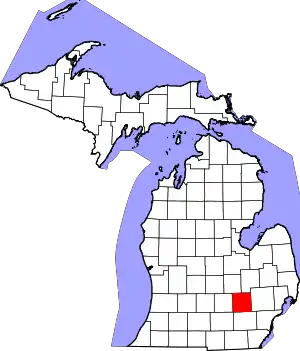Hell, Michigan
Hell is an unincorporated community in Livingston County in the U.S. state of Michigan. As an unincorporated community, Hell has no defined boundaries or population statistics of its own. Located within Putnam Township, the community is centered along Patterson Lake Road about 15 miles (24 km) northwest of Ann Arbor and three miles (4.8 km) southwest of Pinckney. The community is served by the Pinckney post office with the 48169 ZIP Code.
Hell, Michigan | |
|---|---|
 U.S. weather station sign in Hell | |
 Hell Location within the state of Michigan  Hell Hell (the United States) | |
| Coordinates: 42°26′05″N 83°59′06″W | |
| Country | United States |
| State | Michigan |
| County | Livingston |
| Township | Putnam |
| Elevation | 886 ft (270 m) |
| Time zone | UTC-5 (Eastern (EST)) |
| • Summer (DST) | UTC-4 (EDT) |
| ZIP code(s) | 48169 (Pinckney) |
| Area code(s) | 734 |
| FIPS code | 26-37520[2] |
| GNIS feature ID | 628065[1] |
History
Hell developed around a sawmill, gristmill, distillery and tavern. All four were operated by George Reeves, who moved to the area in the 1830s from the Catskill Mountains in New York. He purchased a sawmill on what is now known as Hell Creek in 1841. In addition to the sawmill, Reeves purchased 1,000 acres (400 ha) of land surrounding the mill. Reeves then built a gristmill on Hell Creek which was powered by water that was impounded by a small dam across the creek. Farmers in the area were quite successful in growing wheat and had an abundance of grain. Reeves opened a distillery to process the excess grain into whiskey. Reeves also opened a general store/tavern on his property.[3]
The tavern and distillery soon became a thriving business for Reeves. He built a ballroom on the second floor of the establishment and a sulky racetrack around his millpond. Reeves also sold his alcohol to nearby roadhouses and stores for as little as ten cents a gallon.[3] His operation came under the scrutiny of the U.S. government in the years after the American Civil War. When tax collectors came to Hell to assess his operation, Reeves and his customers conspired to hide the whiskey by filling barrels and sinking them to the bottom of the millpond. When the government agents left the area, the barrels were hauled to the surface with ropes.[3] As Reeves aged he slowed his business ventures, closing the distillery and witnessing the burning of the gristmill. He died in 1877.[3]
Reeves' family sold the land to a group of investors from Detroit in 1924. The investors increased the size of the millpond by raising the level of the dam, creating what is now Hiland Lake. The area soon became a summer resort area, attracting visitors for swimming and fishing. Henry Ford considered building some manufacturing facilities in the area but decided against it.[3]
Etymology
There are a number of theories for the origin of Hell's name. The first is that a pair of German travelers stepped out of a stagecoach one sunny afternoon in the 1830s, and one said to the other, "So schön hell!" (translated as, "So beautifully bright!") Their comments were overheard by some locals and the name stuck.[3] Soon after Michigan gained statehood, George Reeves was asked what he thought the town he helped settle should be called and replied "I don't care. You can name it Hell for all I care." The name became official on October 13, 1841.[3] The second theory is tied to the "hell-like" conditions encountered by early explorers including mosquitos, thick forest cover, and extensive wetlands.[3] The third is that George’s habit of paying the local farmers for their grain with home distilled whiskey led many wives to comment “He’s gone to Hell again” when questioned about their husband’s whereabouts during harvest time.[4] Hell has been noted on a list of unusual place names.[5]
Arts and culture
In the early 1930s, Pinckney, Michigan postmaster W. C. Miller began to receive requests from stamp and postmark collectors for cancellations: Hell had no post office, instead being served by the one for Pinckney, three miles away. On July 15, 1961, a postal substation was established at Hell, operating from May 1 through September 30. It remains at the back of the general store, although the United States Postal Service does not recognize Hell as a town; it instead uses the name of nearby Pinckney as the mailing address.[6]
In 1963, the Hell Chamber of Commerce sponsored a two-day "fun festival" which began with Satan's arrival by helicopter at "Satan's Hills", a local housing development.[7][8]
References
- U.S. Geological Survey Geographic Names Information System: Hell, Michigan
- "U.S. Census website". United States Census Bureau. Retrieved 2008-01-31.
- "The Long History of Hell, MI". Hell2u.com. Archived from the original on 2013-01-26. Retrieved 2010-07-25.
- "History". Retrieved August 26, 2020.
- Parker, Quentin (2010). Welcome to Horneytown, North Carolina, Population: 15: An insider's guide to 201 of the world's weirdest and wildest places. Google Books. Adams Media. pp. x. ISBN 9781440507397.
- USPS.com ZIP code lookup
- "Hell Awaits Satan's Visit" (PDF). Pinckney Dispatch. June 26, 1963. pp. 1, 4.
- "Satan Hills Housing Development In Hell, Michigan, September 1962". Ann Arbor District Library. September 1962.
External links
| Wikivoyage has a travel guide for Hell (Michigan). |
| Wikimedia Commons has media related to Hell, Michigan. |
